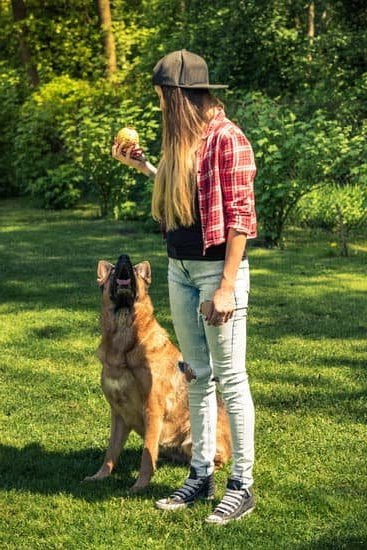Teaching your dog to stand up on command is an essential skill that not only showcases their obedience but also contributes to their overall behavior and well-being. In this article, we will explore the step-by-step process of training your dog to stand up, from establishing a strong foundation in basic obedience to troubleshooting common challenges. By using positive reinforcement techniques and maintaining consistency, you can successfully teach your furry friend this advanced command.
Standing up on command may seem like a relatively simple task, but it has numerous benefits for both you and your dog. Firstly, this command promotes control and discipline, as it requires your dog to stay still until instructed otherwise. This is particularly important in situations where you need them to stand calmly, such as when getting groomed or examined by a veterinarian.
Moreover, teaching the stand-up command can enhance your dog’s concentration and focus. By providing mental stimulation during training sessions, you create an environment that challenges and engages their cognitive abilities. This helps reduce boredom and behavioral problems that often arise due to lack of mental stimulation.
In the following sections, we will guide you through the entire training process, starting with setting a strong groundwork in basic obedience. Before attempting advanced commands like standing up on cue, it’s crucial to ensure that your dog understands fundamental commands such as sit, stay, and come when called.
With patience, consistency, and positive reinforcement techniques at the forefront of your training approach, you’ll be able to teach your dog how to stand up confidently and reliably on command.
Setting the groundwork
Before attempting to train your dog to stand up on command, it is essential to establish a strong foundation in basic obedience. This foundation will not only make the training process smoother but also ensure that your dog is responsive and receptive to learning new commands.
Basic obedience commands such as sit, stay, and come lay the groundwork for more advanced training tasks. They teach your dog important skills such as focus, impulse control, and listening to commands. These skills will be invaluable when teaching your dog to stand up on command.
To begin setting the groundwork for training your dog to stand up, start by focusing on these basic obedience commands. Practice them regularly with your dog until they are consistently reliable in responding. This will create a strong bond between you and your dog and establish trust and understanding.
In addition to basic obedience, it is also important to ensure that your dog has good leash manners before attempting the standing up command. Teaching your dog how to walk politely on a leash will help in controlling their movements during the training process. It will also prevent any potential safety risks or uncontrollable behavior while trying to teach them the standing up command.
Once you have established a solid foundation in basic obedience and leash manners, you can proceed with confidence to train your dog to stand up on command. Remember that patience, consistency, and positive reinforcement are key throughout this process. By laying this strong groundwork, you are setting yourself and your dog up for success in mastering this advanced command.
| Benefits of Establishing Basic Obedience | Importance of Good Leash Manners |
|---|---|
| – Enhances focus and impulse control | – Ensures controlled movements during training |
| – Builds trust and understanding between you and your dog | – Prevents potential safety risks |
| – Creates a strong bond between you and your dog | – Controls uncontrollable behavior |
Pre-training preparations
In order to successfully train your dog to stand up on command, it is important to gather the necessary tools and equipment for your training sessions. These items will not only make the training process more effective, but they will also help create a positive learning environment for your dog.
Treats and rewards
One of the most essential tools for training any dog is a variety of treats and rewards. These should be highly enticing and something that your dog finds particularly delicious or motivating.
Choose treats that are small, soft, and easy to chew so that they can be quickly consumed by your dog during training sessions. It is also beneficial to have a variety of treats on hand, as this will keep the training interesting for your dog and prevent them from becoming bored or disinterested.
Clicker
A clicker is a small handheld device that makes a distinct clicking sound when pressed. This sound serves as a marker to indicate to your dog that they have performed the desired behavior correctly. The clicker can be used in conjunction with treats or rewards as positive reinforcement during training sessions. Before starting the training process, make sure your dog understands the association between the clicker sound and receiving a treat or reward.
Leash and collar/harness
Having a leash and collar or harness is important for keeping control of your dog during training sessions, especially if you are working in outdoor environments where there may be distractions. Make sure you choose the appropriate size of collar or harness that fits your dog comfortably but snugly. The leash should be sturdy and long enough to allow freedom of movement while maintaining control over your dog.
Training mat or designated area
Designate a specific area in your home or outdoors where you will conduct the training sessions with your dog. This could be a dedicated mat or simply an area with clear boundaries. Having a designated training area helps create a focused and controlled environment, which is beneficial for both you and your dog during the training process.
By gathering these tools and equipment before starting the training sessions, you will be setting yourself up for success in teaching your dog to stand up on command. These items will aid in effectively communicating with your dog and reinforcing desired behaviors, making the learning experience enjoyable for both you and your furry friend.
Step-by-step guide
The first step in training your dog to stand up on command is to ensure that they have a solid understanding of the sit command. This is essential because the stand-up command builds upon the sit position. Start by having your dog in front of you and holding a treat near their nose.
Slowly move the treat upward while guiding their body into a sitting position. As soon as your dog sits, reward them with praise and the treat. Repeat this process multiple times until your dog consistently responds to the sit command.
Step 2: Lure into Standing Position
Once your dog has mastered the sit command, you can begin teaching them how to stand up from a sitting position. With your dog in a sitting position, hold a treat just above their head and slowly move it forward towards their nose.
As your dog follows the motion of the treat with their head, their backend will naturally rise off the ground, transitioning them into a standing position. The moment they are standing, reward them with praise and the treat.
Step 3: Add Verbal Cue and Hand Signal
As your dog becomes more comfortable with standing up on command, it’s important to introduce consistent verbal cues and hand signals. Choose simple words or phrases such as “stand” or “up” as your verbal cue, and pair it with a distinct hand signal such as an open palm held up towards your dog’s face. Use these cues consistently during training sessions so that your dog associates them specifically with the action of standing up.
Step 4: Reinforce and Practice
Consistency is key when teaching any new behavior to your dog. Ensure that you reward them immediately every time they successfully stand up on command. Gradually fade out the use of treats over time but continue to reinforce good behavior with praise or occasional rewards. Practice the stand-up command in different locations and gradually introduce distractions to reinforce the behavior in various situations.
Remember, patience is crucial throughout the training process. Dogs learn at their own pace, so it’s important to stay positive and persistent. With consistent practice and positive reinforcement, your dog will soon master the stand-up command, adding another useful skill to their repertoire.
Positive reinforcement techniques
Positive reinforcement techniques play a crucial role in training dogs to stand up on command. By understanding the power of rewards and motivation, you can shape your dog’s behavior and make the training process more enjoyable for both you and your furry friend.
One effective method of positive reinforcement is using treats as rewards. When your dog successfully stands up on command, immediately offer them a small, tasty treat as a reward. This will create a positive association with the behavior and motivate them to repeat it in the future. Be sure to choose treats that are highly enticing to your dog, such as small pieces of cooked chicken or soft training treats.
In addition to treats, verbal praise and physical affection are also important forms of positive reinforcement. When your dog stands up on command, enthusiastically praise them with words like “good job” or “well done” in an upbeat tone. You can also give them gentle pats or scratches as a sign of affection. Dogs thrive on their owner’s approval, so this positive attention will further reinforce the desired behavior.
To enhance motivation during the training process, it can be beneficial to incorporate toys or playtime into the reward system. For example, if your dog successfully stands up on command, reward them by initiating a game of fetch or allowing them to play with their favorite toy for a few minutes. This not only provides additional stimulation but also makes the entire training experience more fun and engaging for your dog.
Using positive reinforcement techniques helps create a positive learning environment for your dog while building their confidence and trust in you as their trainer. As you continue to use rewards and motivation effectively, your dog will become more eager to learn and perform new commands such as standing up on command. Remember to be consistent with your rewards and always provide immediate feedback when they exhibit the desired behavior.
- Use treats as rewards
- Provide verbal praise and physical affection
- Incorporate toys or playtime into the reward system
Common challenges and troubleshooting
One of the most important aspects of dog training is understanding and being prepared for the challenges that may arise during the process. When teaching your dog to stand up on command, it is important to anticipate potential obstacles and have effective solutions in place to overcome them.
One common challenge that may arise is the lack of motivation or interest from your dog. Some dogs may be more difficult to train than others, and if your dog is not enthusiastic about learning this command, it may hinder progress. In order to address this, it is crucial to use positive reinforcement techniques consistently throughout the training process.
This involves rewarding your dog with treats, praise, or play as soon as they successfully execute the stand-up command. By associating the desired behavior with a positive outcome, you can motivate your dog and increase their enthusiasm for learning.
Another challenge that may occur is confusion or misunderstanding from your dog. Dogs rely heavily on body language and cues from their owners, so it is important to be clear and consistent when training them. To prevent confusion, use clear and distinct hand signals or verbal cues when giving the stand-up command. Additionally, breaking down the training process into smaller steps can help prevent overwhelm and make it easier for your dog to understand what is expected of them.
Furthermore, distractions in the environment can pose a challenge during training sessions. Dogs are easily distracted by sights, sounds, and smells in their surroundings. To address this obstacle, gradually introduce distractions into your training sessions once your dog has successfully mastered the stand-up command in a controlled environment. Start with mild distractions such as toys or low-level noises and gradually increase the difficulty level as your dog becomes more proficient.
By being aware of these challenges and having effective solutions in place, you can ensure a smoother training experience for both you and your dog.
| Challenge | Solution |
|---|---|
| Lack of motivation | Use positive reinforcement techniques consistently and reward your dog for successful execution of the command. |
| Confusion or misunderstanding | Be clear and consistent with your cues and break down the training process into smaller steps. |
| Distractions in the environment | Gradually introduce distractions during training sessions once your dog has mastered the command in a controlled environment. |
Practice makes perfect
After setting the groundwork and preparing for training sessions, it is time to establish a regular training routine to strengthen your dog’s standing up command. Consistency and repetition are key in helping your dog understand and retain this new behavior. By incorporating regular practice sessions into your daily routine, you can help solidify your dog’s understanding of the command.
Start by designating a specific time and place for training sessions. This will create a structured environment that signals to your dog that it is time to focus and learn. Consistency in the training location will also prevent confusion and distractions that may hinder progress.
During each training session, keep the duration short but focused. Dogs have short attention spans, so it is important to keep the exercises engaging and varied. Begin by practicing the basic command of “sit” or “down” before giving the cue for “stand up.” This will remind your dog of the foundation they have already learned while introducing the new desired behavior.
Repetition is crucial in reinforcing commands. Repeat the stand-up command multiple times during each session, making sure to reward your dog with praise or treats every time they successfully perform the behavior. Consistency in using the same verbal cues and hand signals will also help solidify their understanding of what you expect from them.
As your dog becomes more comfortable with the standing up command, gradually increase the difficulty level. You can try using hand signals alone without verbal cues, adding distractions such as toys or other people in the vicinity, or practicing in different locations to generalize their understanding of the command.
Remember that each dog learns at their own pace, so be patient and celebrate even small successes along the way. With consistent practice and positive reinforcement techniques, you will soon have a well-trained companion who can confidently stand up on command in various situations.
By establishing a regular training routine and incorporating repetition into your sessions, you are ensuring that your dog has ample opportunity to practice their standing up command. This consistent and focused approach will not only strengthen their understanding of the behavior but also improve their overall obedience and responsiveness to your commands.
Taking it to the next level
Once your dog has mastered the basics of standing up on command, it’s time to challenge them and gradually increase the difficulty level. This will not only reinforce their understanding of the command but also ensure that they can respond in various situations and environments. Here are some steps you can follow to take your dog’s training to the next level:
- Introduce distractions: Start by adding mild distractions during your training sessions. For example, have a family member walk past or wave a toy in front of your dog while giving the stand-up command. Gradually increase the level of distraction as your dog becomes more proficient at responding.
- Change locations: Practice the stand-up command in different areas, both indoors and outdoors. Move to different rooms in your house or go to a park or other public places where there may be more distractions. This will help generalize your dog’s understanding of the command.
- Increase distance: Once your dog can perform the stand-up command consistently at close range, begin increasing the distance between you and your dog when giving the command. Start by taking a step back, then gradually increase the distance over time.
- Add duration: Work on extending how long your dog stays in a standing position after receiving the command. Begin with just a few seconds and gradually build up to longer durations. This will help strengthen their patience and focus.
Remember to always reward your dog for successfully completing each new challenge and continue using positive reinforcement techniques throughout this process. Patience is key, as some dogs may progress more quickly than others.
By gradually increasing difficulty and adding distractions, you are solidifying your dog’s understanding of the stand-up command in a variety of situations. This will make them more reliable and responsive overall, laying a strong foundation for further training endeavors.
Incorporate these steps into your training routine and continue to practice regularly. Consistency is essential for maintaining and reinforcing your dog’s skills. With time and dedication, your furry friend will become a pro at standing up on command in any situation.
Maintaining consistency and generalizing the command
Once your dog has mastered the stand-up command in a controlled training environment, it is important to begin generalizing the command so that your dog can perform it reliably in different settings and situations. This step is crucial for ensuring that your dog understands that the command applies regardless of the context or location.
To start generalizing the stand-up command, begin practicing in different areas of your home. Slowly introduce distractions such as toys, noises, or other people while giving the command. It is important to gradually increase difficulty and add distractions to help solidify your dog’s understanding of the command.
As your dog becomes more comfortable and proficient in responding to the stand-up command at home, you can start practicing in various outdoor environments. Public parks, busy streets, or even friend’s houses are great places to test your dog’s response to the command. Remember to keep practicing patience and consistently reward your dog for successfully performing the behavior.
It is also essential to practice the stand-up command during different daily routines such as mealtime or before going for a walk. By incorporating these routine activities into training sessions, you are teaching your dog that they need to respond to this command regardless of what else may be happening around them.
Remember that each new environment or situation may present its own unique challenges and distractions for your dog. Be patient with them as they adjust and reinforce proper behavior through rewards and positive reinforcement. Consistency is key throughout this process, so continue reinforcing good behavior every time your dog successfully responds to the stand-up command.
By maintaining consistency and generalizing the stand-up command across various environments and situations, you are ensuring that your dog will respond reliably no matter where you are or what may be happening around them. This level of understanding will make their obedience more reliable and reinforce their ability to follow commands even in the face of distractions. Through patience, consistency, and positive reinforcement, you can successfully train your dog to stand up on command in any situation.
Conclusion
In conclusion, training your dog to stand up on command is an advanced skill that can be achieved with patience, consistency, and positive reinforcement. Throughout this article, we have emphasized the importance of establishing a strong foundation in basic obedience before attempting this command. By setting the groundwork and gathering the necessary tools and equipment, you will be better prepared to train your dog effectively.
We have provided a step-by-step guide to break down the training process into manageable steps. These steps allow for a smooth learning experience for your dog and help them understand the desired behavior. Positive reinforcement techniques, such as rewards and motivation, play a crucial role in shaping your dog’s behavior. By using these techniques consistently and appropriately, you can encourage your dog to stand up on command.
It is important to acknowledge that challenges may arise during the training process. However, by addressing potential obstacles and providing effective solutions, you can overcome them successfully. Remember that practice makes perfect, so establishing a regular training routine and incorporating repetition will strengthen your dog’s understanding of the stand-up command.
As you progress in training your dog to stand up on command, it is essential to take it to the next level gradually. Increasing difficulty and adding distractions will solidify their understanding of the command in various environments and situations. Ultimately, maintaining consistency and generalizing the command are key factors in ensuring your dog responds reliably in any given situation.
Frequently Asked Questions
How do I get my dog to stand up?
To get your dog to stand up, you can use a simple verbal cue combined with a physical gesture. Start by standing in front of your dog and using a clear and consistent word like “stand.” At the same time, hold a treat or toy slightly above their nose, just out of reach.
This will encourage them to lift their head and body upwards. As soon as they are fully upright, praise them and provide the treat or play with the toy as a reward. With consistent practice and positive reinforcement, your dog will understand that the cue “stand” means to rise up from a sitting or lying down position.
How do I teach my dog to stand on his hind legs?
Teaching your dog to stand on their hind legs can be done through a process called “begging.” Begin by having your dog sit in front of you. Hold a treat or toy just above their head for them to see but keep it out of reach. As they try to reach for it, they naturally will lift their front paws off the ground and may shift onto their hind legs partially.
When this happens, reward them immediately with praise and the treat or toy. Gradually increase how long you ask them to stay in this position before giving the reward. By consistently practicing this exercise in short sessions, your dog will learn that standing on their hind legs is associated with positive reinforcement.
How do you teach a dog to stand on command?
Teaching a dog to stand on command follows similar principles as teaching other basic commands like sit or stay. Start by choosing a specific word such as “stand” or any other cue you prefer. Use this word consistently whenever you want your dog to stand up from any position.
Begin with simple exercises where your dog is already standing at attention; say the command clearly while showing them a treat or toy as motivation, then give praise when they follow through. Repeat this exercise in various locations until they start associating the command with standing up no matter where they are positioned initially. Over time and with consistent rewards and praise, your dog will learn to stand on command reliably.

Welcome to the blog! I am a professional dog trainer and have been working with dogs for many years. In this blog, I will be discussing various topics related to dog training, including tips, tricks, and advice. I hope you find this information helpful and informative. Thanks for reading!





